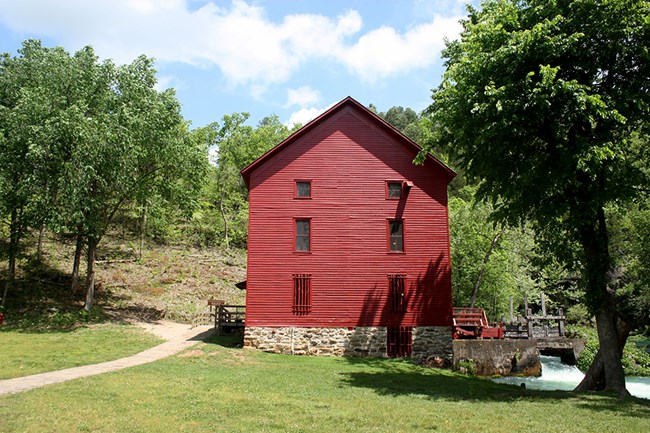Last updated: December 15, 2021
Article
Ozark National Scenic Riverways and Missouri Department of Conservation Partnership Prescribed Burn Enhances Protection of Iconic Alley Spring Mill

NPS, Jamie Ladner
Built in 1894, the Alley Spring Mill symbolizes the cherished natural and cultural resources within Ozark National Scenic Riverways. Featured on the 2017 Missouri quarter, it deserves all the protection it can be given. Consequently, 785 acres surrounding Alley Spring are in a prescribed burn unit to reduce woody fuel.
Additionally, Eastern red cedars were removed from much of the burn unit to minimize the potential of a crown fire during the most severe dry and windy weather. Removal of cedar trees near the historic mill also improved air flow, making it less vulnerable to rot.
Since the hills surrounding Alley Mill were historically a mix of rocky glades and open woodlands, the cedar removal and fire restores both the historic cultural landscape and the natural biodiversity of the glades and woodlands. Pre-burn versus post-burn data from permanent monitoring plots in this burn unit show a 110% increase in the species richness of native wildflowers and grasses following prescribed fire management.
Two months after the March 2021 prescribed burn, park staff discovered a population of 94 wild dill wildflowers (Perideridia americana), listed as imperiled in Missouri. This is the only wild dill population known on National Park Service land in Missouri. It is known to be a wildflower that benefits from dormant season prescribed fire.
Park staff also found several populations of yellow lady-slipper orchids (Cypripedium calceolus), in a glade-to-woodland transition area. Although these orchids are not listed as rare in Missouri, they are uncommon. Detailed population monitoring of this popular wildflower in burn units at Meramec State Park showed populations increased after dormant season prescribed fire.
